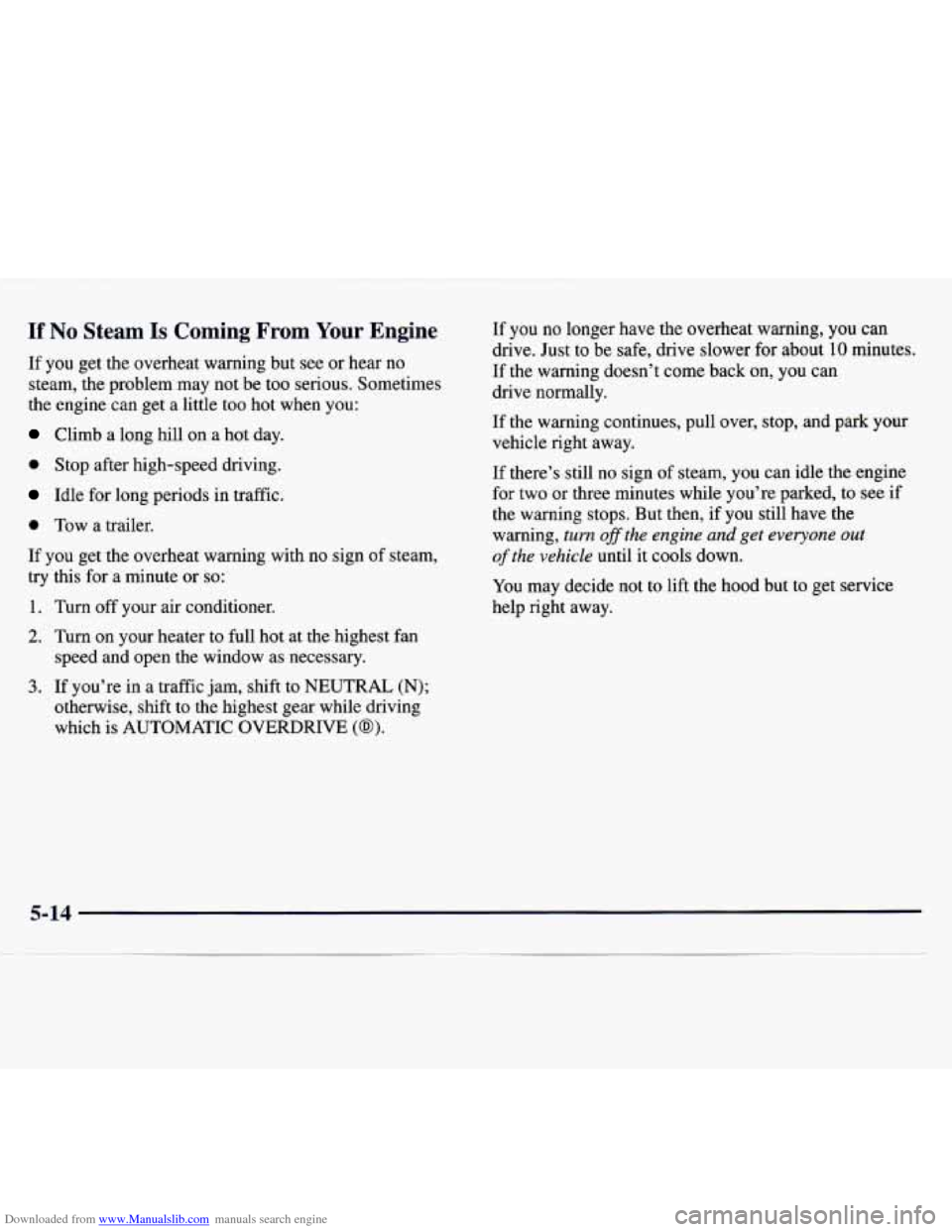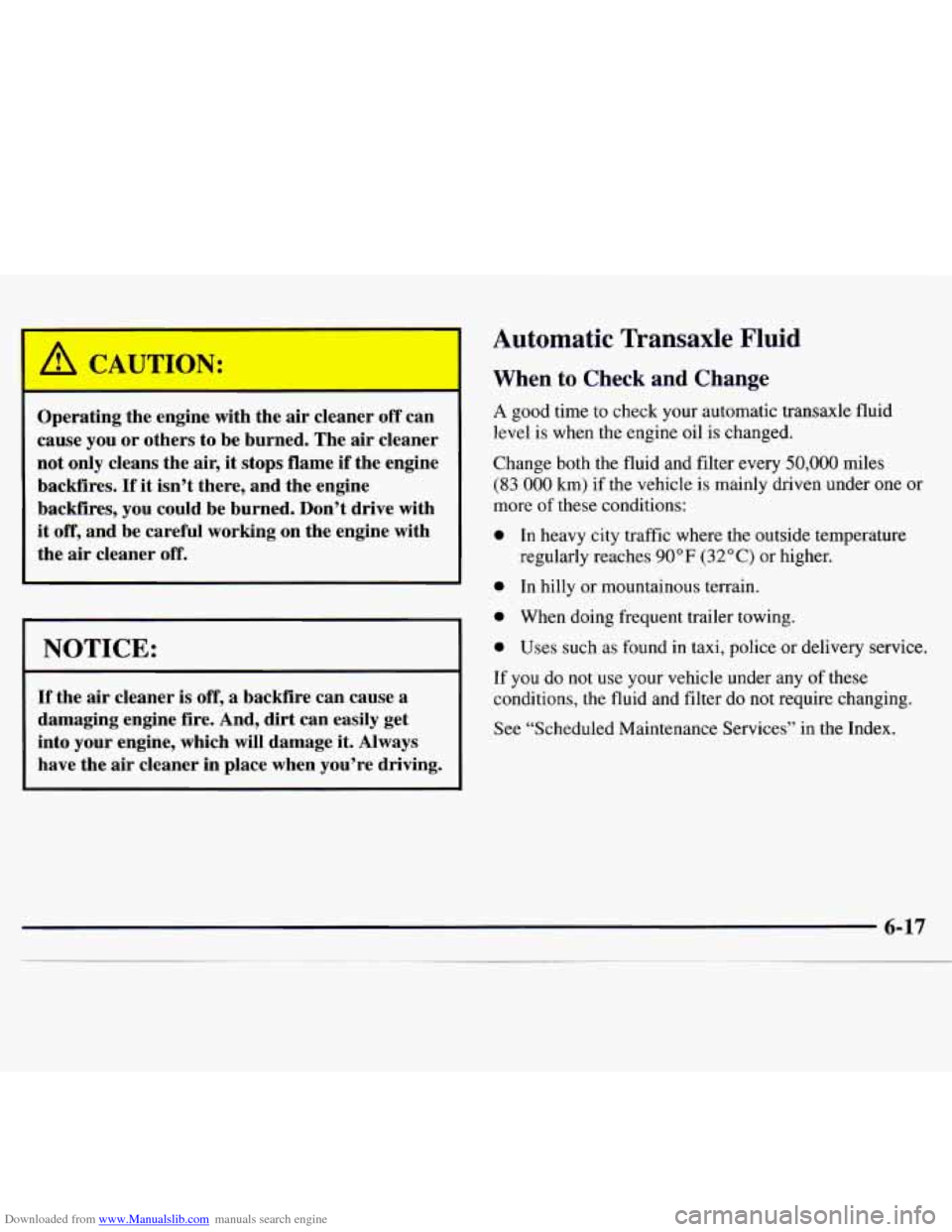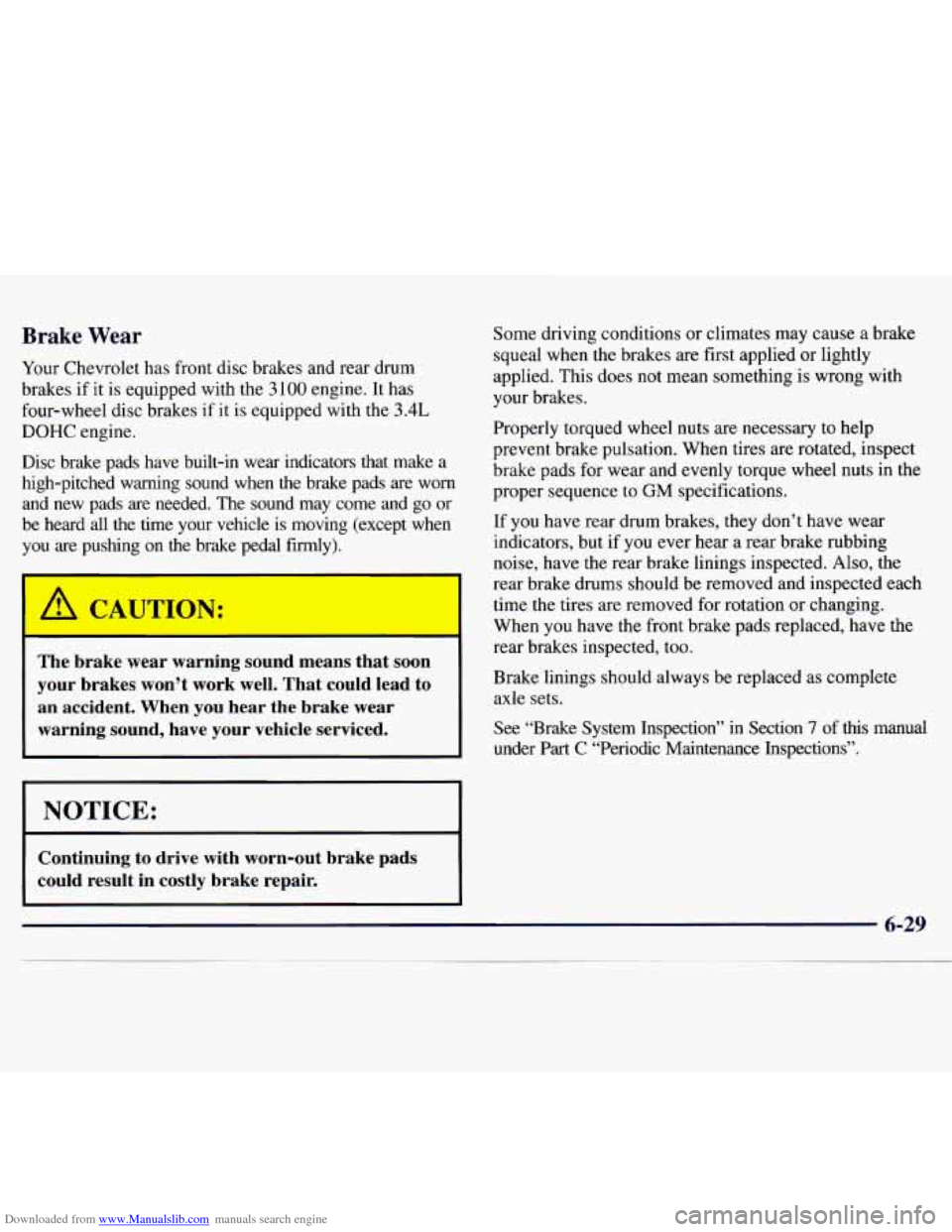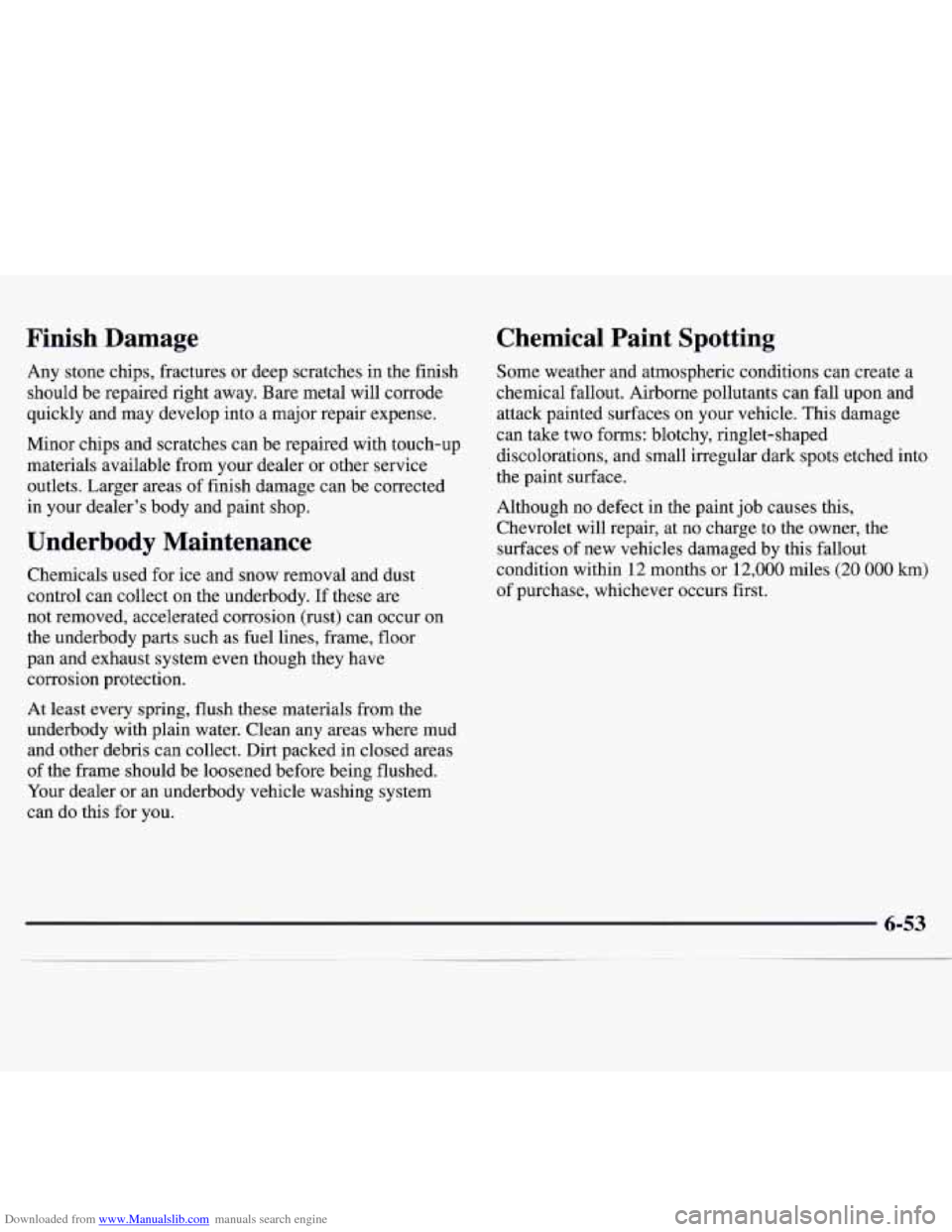1997 CHEVROLET MONTE CARLO air condition
[x] Cancel search: air conditionPage 191 of 358

Downloaded from www.Manualslib.com manuals search engine If No Steam Is Coming From Your Engine
If you get the overheat warning but see or hear no
steam, the problem may not be too serious. Sometimes
the engine can get a little too hot when you:
Climb a long hill on a hot day.
0 Stop after high-speed driving.
Idle for long periods in traffic.
e Tow a trailer.
If you get the overheat warning with no sign of steam,
try this for a minute or
so:
1. Turn off your air conditioner.
2. Turn on your heater to full hot at the highest fan
speed and open the window as necessary.
3. If you’re in a traffic jam, shift to NEUTRAL (N);
otherwise, shift to the highest gear while driving
which is AUTOMATIC OVERDRIVE
(a).
If you no longer have the overheat warning, you can
drive. Just to be safe, drive slower for about
10 minutes.
If
the warning doesn’t come back on, you can
drive normally.
If the warning continues, pull over, stop, and park your
vehicle right away.
If there’s still no sign of steam, you can idle the engine
for two or three minutes while you’re parked, to see if
the warning stops. But then, if you still have the
warning,
turn ofthe engine and get everyone out
of the vehicle until it cools down.
You may decide not to lift the hood but to get service
help right away.
5-14
Page 216 of 358

Downloaded from www.Manualslib.com manuals search engine 0 Section 6 Service and Appearance Care
Here you will find information about the care of your Chevrolet. This section begins with service and fuel
information, and then
it shows how to check important fluid and lubricant levels. There is also technical information
about your vehicle, and a part devoted to its appearance care.
6-2
6-3
6-4 6-5
6-7 6- 10
6-16
6- 17
6-20
, 6-24 6-25
6-27
6-30
6-3
1
6-3 1
6-37 6-37 6-45
Service
Fuel
Fuels in Foreign Countries
Filling Your Tank
Checking Things Under the Hood
Engine Oil
Air Cleaner
Automatic Transaxle Fluid
Engine Coolant
Power Steering Fluid
Windshield Washer Fluid
Brakes Battery
Bulb Replacement
Halogen Bulbs
Windshield Wiper Blade Replacement
Tires
Appearance Care 6-46
6-50
6-50
6-50
6-50 6-5 1
6-52 6-52
6-5
2
6-5 3 6-5 3
6-53 6-54
6-55
6-55
6-56
6-65
Cleaning the Inside of Your Chevrolet
Care
of Safety Belts
Cleaning Glass Surfaces
Cleaning the Outside of
the Windshield and
Wiper Blades
Weatherstrips
Cleaning the Outside of Your Chevrolet
Cleaning Aluminum Wheels (If Equipped)
Cleaning Tires Sheet Metal Damage
Finish Damage
Underbody Maintenance
Chemical Paint Spotting
Appearance Care Materials Chart
Vehicle Identification Number (VIN)
Service Parts Identification Label
Electrical System
Air Conditioning Refrigerants
6-1
Page 218 of 358

Downloaded from www.Manualslib.com manuals search engine Adding Equipment to the Outside of
Your Vehicle
Things you might add to the outside of your vehicle can
affect the airflow around it. This may cause wind noise
and affect windshield washer performance. Check with
your Chevrolet dealer before adding equipment to the
outside of your vehicle.
Fuel
Use regular unleaded gasoline rated at 87 octane or
higher. At a minimum, it should meet specifications
ASTM D4814 in the United States and CGSB 3.5-M93
in Canada. Improved gasoline specifications have been
developed
by the American Automobile Manufacturers
Association (AAMA) for better vehicle performance
and engine protection. Gasolines meeting the AAMA
specification could provide improved driveability and
emission control system protection compared to
other gasolines.
Be sure the posted octane is at least
87. If the octane is
less than 87, you may get a heavy knocking noise when
you drive. If it’s bad enough, it can damage your engine.
If you’re using fuel rated at
87 octane or higher and you
hear heavy knocking, your engine needs service. But
don’t worry
if you hear a little pinging noise when
you’re accelerating or driving up a hill. That’s normal, and you don’t
have to buy a higher octane fuel to get rid
of pinging. It’s the heavy, constant knock that means
you have a problem.
If your vehicle is certified to meet California Emission
Standards (indicated
on the underhood tune-up label), it
is designed to operate
on fuels that meet California
specifications. If such fuels
are not available in states
adopting California emissions standards, your vehicle will operate satisfactorily on
fuels meeting federal
specifications, but emission control system performance
may be affected. The malfunction indicator lamp on
your instrument panel may turn on and/or your vehicle
may fail a smog-check
test. If this occurs, return to your
authorized Chevrolet dealer for diagnosis to determine
the cause of failure. In the event it is determined that the
cause
of the condition is the type of fuels used, repairs
may not
be covered by your warranty.
Some gasolines that are not reformulated for low
emissions contain an octane-enhancing additive called
methylcyclopentadienyl manganese tricarbonyl (MMT);
ask your service station operator whether or not his fuel
contains MMT. General Motors does not recommend the
use of such gasolines. If fuels containing MMT are used,
spark plug life may be reduced and your emission
control system performance may be affected. The
malfunction indicator lamp on your instrument panel
Page 232 of 358

Downloaded from www.Manualslib.com manuals search engine r--
Operating the engine with the air cleaner off can
cause you or others to be burned. The
air cleaner
not only cleans the air, it stops flame if the engine
backfires.
If it isn’t there, and the engine
backfires, you could be burned. Don’t drive with
it off, and be careful working on the engine with
the air cleaner
off.
I NOTICE:
If the air cleaner is off, a backfire can cause a
damaging engine fire. And, dirt can easily get
into your engine, which will damage
it. Always
have the
air cleaner in place when you’re driving.
Automatic Transaxle Fluid
When to Check and Change
A good time to check your automatic transaxle fluid
level
is when the engine oil is changed.
Change both the fluid and filter every
50,000 miles
(83 000 km) if the vehicle is mainly driven under one or
more of these conditions:
0 In heavy city traffic where the outside temperature
regularly reaches
90°F (32°C) or higher.
0 In hilly or mountainous terrain.
0 When doing frequent trailer towing.
0 Uses such as found in taxi, police or delivery service.
If you do not use your vehicle under any of these
conditions, the fluid and filter do
not require changing.
See “Scheduled Maintenance Services” in the Index.
Page 244 of 358

Downloaded from www.Manualslib.com manuals search engine Brake Wear
Your Chevrolet has front disc brakes and rear drum
brakes if it is equipped with the
3 100 engine. It has
four-wheel disc brakes if it is equipped with the
3.4L
DOHC engine.
Disc brake pads have built-in wear indicators that make a
high-pitched warning sound when the brake pads are worn and new pads
are needed. The sound may come and go or
be heard all the time your vehicle is moving (except when
you
are pushing on the brake pedal firmly).
I
The brake wear warning sound means that soon
your brakes won’t work well. That could lead to an accident. When you hear the brake wear
warning sound, have your vehicle serviced.
I NOTICE:
Continuing to drive with worn-out brake pads
could result in costly brake repair.
Some driving conditions or climates may cause a brake
squeal when the brakes are first applied or lightly
applied. This does not mean something is wrong with
your brakes.
Properly torqued wheel nuts are necessary to help
prevent brake pulsation. When tires are rotated, inspect
brake pads for wear and evenly torque wheel nuts in the
proper sequence to GM specifications.
If
you have rear drum brakes, they don’t have wear
indicators, but if
you ever hear a rear brake rubbing
noise, have the rear brake linings inspected. Also, the
rear brake drums should be removed and inspected each
time the tires are removed for rotation or changing.
When you have the front brake pads replaced, have the
rear brakes inspected, too.
Brake linings should always be replaced as complete
axle sets.
See “Brake System Inspection” in Section 7 of this manual
under
Part C “Periodic Maintenance Inspections”.
Page 258 of 358

Downloaded from www.Manualslib.com manuals search engine Temperature -- A, B, C
The temperature grades are A (the highest), B, and C,
representing the tire’s resistance to the generation of
heat and its ability to dissipate heat when tested under
controlled conditions on
a specified indoor laboratory
test wheel. Sustained high temperature can
cause the
material of the tire to degenerate and reduce tire life, and
excessive temperature can lead to sudden tire failure.
The grade
C corresponds to a level of performance
which all passenger car tires must meet under the
Federal Motor Vehicle Safety Standard
No. 109. Grades
B and A represent higher levels of performance on the
laboratory test wheel than the minimum required by law.
Warning: The temperature grade for this tire is
established for
a tire that is properly inflated and not
overloaded. Excessive speed, underinflation, or
excessive loading, either separately or in combination,
can cause heat buildup and possible tire failure.
Wheel Alignment and Tire Balance
The wheels on your vehicle were aligned and balanced
carefully at the factory to give you the longest tire life
and best overall performance.
Scheduled wheel alignment and wheel balancing are not
needed. However,
if you notice unusual tire wear or
your vehicle pulling one way or the other, the alignment
may need to be reset.
If you notice your vehicle
vibrating when driving
on a smooth road, your wheels
may need to be rebalanced.
Wheel Replacement
Replace any wheel that is bent, cracked, or badly rusted
or corroded. If wheel nuts keep coming loose, the wheel,
wheel bolts and wheel nuts should be replaced.
If the
wheel leaks air, replace it (except some aluminum
wheels, which can sometimes be repaired). See your
Chevrolet dealer
if any of these conditions exist.
Your dealer will know the kind of wheel you need.
6-43
Page 268 of 358

Downloaded from www.Manualslib.com manuals search engine Finish Damage
Any stone chips, fractures or deep scratches in the finish
should be repaired right away. Bare metal will corrode
quickly and may develop into a major repair expense.
Minor chips and scratches can be repaired with touch-up
materials available from your dealer or other service
outlets. Larger areas
of finish damage can be corrected
in your dealer’s body and paint shop.
Underbody Maintenance
Chemicals used for ice and snow removal and dust
control can collect
on the underbody. If these are
not removed, accelerated corrosion (rust) can occur on
the underbody parts such as fuel lines, frame, floor
pan and exhaust system even though they have
corrosion protection.
At least every spring, flush these materials from
the
underbody with plain water. Clean any areas where mud
and other debris can collect. Dirt packed in closed areas
of the frame should be loosened before being flushed.
Your dealer or an underbody vehicle washing system
can do this for you.
Chemical Paint Spotting
Some weather and atmospheric conditions can create a
chemical fallout. Airborne pollutants can fall upon and
attack painted surfaces on your vehicle. This damage
can take two forms: blotchy, ringlet-shaped
discolorations, and small irregular dark spots etched into
the paint surface.
Although no defect in the paint job causes this,
Chevrolet will repair, at no charge to the owner, the
surfaces of new vehicles damaged by this fallout
condition within
12 months or 12,000 miles (20 000 km)
of purchase, whichever occurs first.
Page 278 of 358

Downloaded from www.Manualslib.com manuals search engine Replacement Bulbs
Exterior Lamps Bulb Number
Back-up ......................... 3 156 or 3057
Center High-Mounted Stop
............... 891T2
Front ParkingiTurn Signal
............... 3357NA
Headlamp, High-Beam
................... 9005
Headlamp, Low-Beam
.................... 9006
Sidemarker, Front
......................... 194
Sidemarker, Rear
......................... 194
Stop/Tail/Turn Signal
..................... 3057
Interior Lamps Bulb Number
Dome ............................. 10230955
*For service information
on these bulbs, contact your
Chevrolet dealer service department.
Capacities and Specifications
Please refer to “Recommended Fluids and Lubricants”
in
the Index for more information.
Automatic Transaxle
Pan Removal and Replacement ..... 7 quarts (6.7 L)
After Complete Overhaul
......... 10 quarts (9.5 L)
When drainingh-eplucing convertel; more fluid muy
be needed.
Cooling System Including Reservoir
3100 (Code M) .............. 11.6 quarts (10.94 L)
3.4L DOHC (Code
X) ........ 12.3 quarts (1 1.65 L)
Refrigerant (R-l34a),
Air Conditioning* ....... 1.88 pounds (0.85 kg)
Engine Crankcase - Oil and Filter Change
3100 (Code M) ................ 4.5 quarts (4.2 L)
3.4L DOHC (Code
X) .......... 5.5 quarts (5.2 L)
Windshield Wiper Blade Replacement
Length .................... 22 inches (559 mm)
Type
.................................. hook
Fuel Tank
3100 (Code M) .............. 16.6 gallons (62.8 L)
3.4L DOHC (Code
X) ........ 16.6 gallons (62.8 L)
*See “Air Conditioning Refrigerants” later in this section.
Note: All capacities are approximate. When adding,
be sure to
Jill to the approximate level, as
recommended in this manual. See “Recommended
Fluids and Lubricants” in the Index.